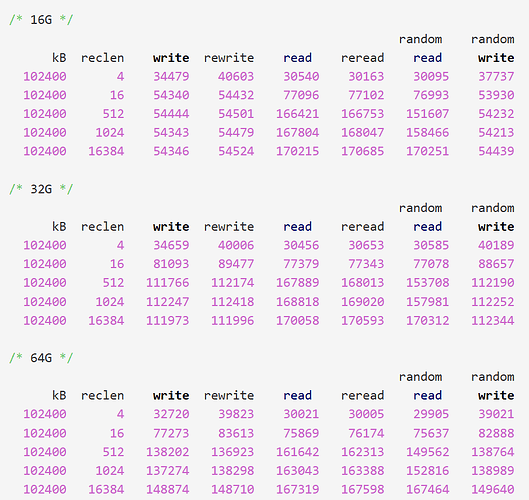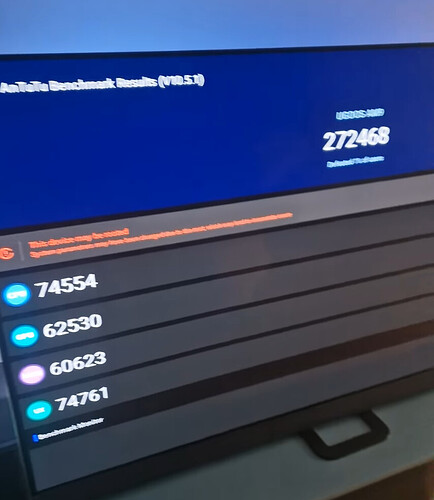thanks for reporting. it’s the same UI issues that a select few are going through. I suspect you’ll have the paste url in your log, it’s running but the UI isn’t working. the developer is aware and is working on a fix. you could grab it from the log in the meantime if you want. I had no idea how many S905X4 boxes their are out their. THX
Just got my Vontar X4 4GB/32GB here are the results, this is running off an SD card
sorry for late reply, I’ve added your score (impressive) thankyou
I wonder what the reason is behind Dolby Laboratories to do this. How soon before Kodi on windows gets this.
while on his subject, something important and unexpected was uncovered while collecting the scores of single core python results
the python version Kodi on windows is using is 3.8 , from 3.8 to 3.9 their was a massive performance benefit for python.
To illustrate this have a look at the Vero V which is using CPython v.3.9.2 scoring 25,864, while the similar SOC in TOX3 scores 58,304.
the both using similar S905X4 , and other boxes using that chipset are in line with TOX3, I asked the person to rerun and it still came down that much.
After being aware of this Sam from Vero V looked into this and shared this
FWIW, I found some time to backport Python 3.11 to OSMC on Debian Bullseye.
There are indeed performance improvements and they are significant. However there are hard dependencies on Python 3.9 for services like Samba and even DBus. We could adjust these dependencies and things would probably work fine, but there’s a high possibility of introducing breakage or unexpected behaviour. It’s not worth it when Debian Trixie has now hit hard freeze.Once we update to Debian Trixie when it goes stable, OSMC will ship with Python 3.13 by default.
As a result, users should see a significant speedup of add-on performance in the near future.
https://forum.kodi.tv/showthread.php?tid=376035&pid=3233518#pid3233518
all this time I thought Windows was just slower because it’s more bloated but for part of the stack (python) it’s held back by the python version it’s using. How much will be revealed when Kodi updates to any version above 3.9
You can run this on windows yourself the pystone benchmark.
So I made a thread asking if anyone is aware of the significance of this and a possible time line for an update, it seems no one is and I don’t think they knew it’s that big of a gap? I wonder how long it takes to update, even to 3.9
https://forum.kodi.tv/showthread.php?tid=381891&pid=3234410#pid3234410
Hoping it stirs devs using windows to look into this. and I get to test out out the performance increase.
If Kodi basically doubles in speed for addons over night, we also have DV FEL working in future, I wonder if their’ll be some work on stripping down Windows just to run Kodi lol.
How much of this is from microsoft? what if they want start building on their own apps and get Netflix to create one, and have a nice launcher
I doubt most users are using Windows but are using TV boxes ie. with s904x4 etc.
agree, but windows is marching forward. The cost of your TOX3 is $59.36
You can get a GMKtek G3 Mini for $98
The scores are as follow
TOX3: 58,304
G3 Mini: 331,408
468% more performance for 65% more cost. you’ll be running in LE but literally zero difference in audio and video EXCEPT. where CE comes through and no one talked about until a few from my group discovered it was this
[RPi5] Over-Saturated Coloring
and Chewitt’s response
The media is 4K HDR, so when you start playback the TV is switched from SDR to HDR mode. This means everything is now in HDR mode so the OSD and (if you navigate out of playback) the Desktop will have saturated colours. Some platforms that Kodi supports (Android, Windows) can sometimes tonemap the OSD etc. to normalise the appearance, but on Linux and with low-power ARM SoC devices (as with Android) this is normally done using a dedicated hardware image processor function in the SoC (as doing it on the CPU is too intensive) and RPi boards do not have this capability (and even on devices that have it, software support in the kernel is rarely implemented in upstream Linux). There might be a possibility to improve things a little with shaders, but this is still something to be explored on the Kodi end.
In short, it’s currently working as intended/capable/expected and this is not a bug.
CoreELEC has an option somehow that doesn’t have this behaviour (or should I say fixes this behaviour) my friend would love to use his N100 box but because of this he can’t. Allot of users care about speed of addons while sill having a great picture and audio quality. If only they did DV MEL.
here is a review of the N150 if you are interested
The Pi5 seems is allot more expensive while being inferior for kodi purposes.
anyway having choise is great and more boxes is great. pick what you value and what your budget allows
This is starting to move away from true CE discussion. There’s still no point for all of this python tests. Those numbers are just numbers, maybe you can use them to bet on loto or something. there’s no point in continuing with this and there are already enough CE results.
We can reopen if something useful about this emerges.
would you be able to run a benchmark to see the pyscore result? interested in comparing it against the S905X4 in the TOX3
![]()
the addon is here
https://kodi.tv/addons/omega/script.pystone.benchmark/
we have the S905X5M from xiaomi also that is running in android.
results are here
THX
I was doing some research and found this,
The Onn 4k Pro with the S905X4 scores 35,357 score in the benchmark
compare that to the best S905X4 running CoreELEC you get a score of 57,819 with the vontar x4
I’m using results with the same CPyhon version
that’s a (57,819/35,357=) 63.5% improvement using CoreELEC.
So using the ONN 4K Plus with the S905X5M scoring 48,810, and applying the 63.5% improvement using CoreELEC, we should see a score of (48,810*1.635=) 79804.35
The Onn 4k Plus only has 2GB RAM but the pi4 2GB and Pi4 8GB are only 0.5% difference in score but that’s using the same OS, the improvements probably be a bit higher?
The Homatics Box R 4k Plus (with the S905X4-K which does FEL + 3D) scores, 57,778, giving the Odroid C5 a potentially theoretical 38% faster chipset
Just to give a comparison the S928X-J on the x96-x10 pro has a score of 191,621
You get 8GB RAM and 64GB storage, and according to Odroid themselves the bigger the storage the faster the speed of it
https://wiki.odroid.com/accessory/emmc/reference_chart#emmc_readwrite_test_on_odroid-c2_hs400_mode
well you most likely should get the 8GB EMMC (since it’s needed according to Portisch and according to this post
https://forum.odroid.com/viewtopic.php?t=23453
You are better of getting a fast microSD card, something like the Samsung cards.
But the 64GB on the X96-X10 will b pretty fast and that scores 191,621, which will make it (191,621/79804.35=) 140% faster than the Odroid C5 in single threaded python speed (if my guess is correct)
anyway just speculating and thought to share
Source for benchmarks
EDIT: something else I found, if you look in that odroid wiki you will see
they are comparing a SanDisk with the EMMC, the Sandisk is the Sandisk Edge
https://www.mouser.co.uk/ProductDetail/SanDisk/SDSDQAD-016G?qs=EgF7oUuTQmrxxaRr8zFE%252BA%3D%3D
and I found this RPi thread that has the sandisk Edge comparing to the Samsung pro plus
https://forums.raspberrypi.com/viewtopic.php?t=358803
“Also, here’s genuine Sandisk Edge 128GB A1 U1 C10 class card in comparison:-
Sequential write speed 27397 KB/sec (target 10000) - PASS
Random write speed 879 IOPS (target 500) - PASS
Random read speed 2518 IOPS (target 1500) - PASS”
I’m guessing the Random read speed is most relevant to boot speed?
so Odroid are saying that EMMC is around 78% than the sandisk
and from the Pi forum the samsung pro plus will have boot load times as
(322518/4678=) 17.2 second to
(352518/4678=) 18.8 second
basically it should be close the EMMC speeds.
I always thought EMMC is faster but the data says a fast card can probably just as fast if not faster, especially if you are getting say a 16GB EMMC card
the samsung pro plus goes on sale in the UK all the time, the 128GB card was as low as £8.39 last December
The 8GB EMMC cost £20.40 , not including delivery.
You’re probably better of getting the 8GB EMMC and then get a Samsung Pro plus when on sale £12 for 128GB is common, last year the 256GB went for £17 in black Friday sale
THX
Someone has already got their hands on the AM9 box with antutu results too
https://www.reddit.com/r/AndroidTVBoxes/comments/1lqkrom/ugoos_am9_sealed_box/
and the antutu score is 272468
Not sure where he got it from but he had a picture of the russian site asking about coreelec
https://www.reddit.com/r/CoreELEC/comments/1lh27fq/ugoos_am9_coreelec/
and the SK1 from Ugoos has a score of 309177
The SK1 is 13.5% faster in this benchmark
The AM6B+ scores 160683
this is different version of antutu for the am6B+ so I’m not sure how it affects score, pretty sure it’s higher in the newer versions of antutu
@freddy thankyou, how did you manage to get 11% improvement? that’s crazy! I’ve seen CoreELEC was bumped up from 3.13.7 (previous 3.12.10) (Thankyou Team-CoreELEC), but that can’t be it. a Pi5 is 256k, the X96-X10 is only 17% off that now. I’m impressed!
updated sheet
Yes ,is nice improvement!!
Team CoreELEC !!!
Looks like you have added VS 10 processing to the X96X10 PRO!!
Although I said not petition, I would move the X96X10 PRO to 13th place !!!
Happy Testing ![]()
I think this is more to do with Cpython version than CoreELEC, have a look at the sheet and notice Ultraman’s score, he has almost exactly the same 11% increase, using LibreELEC and he also bumped python version from 3.12.10 to 3.13.17
It could be moving from 3.13.15 (what window has now) to 3.13.17 gives you that 11%?






